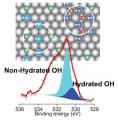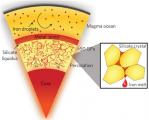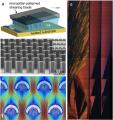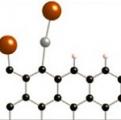Polymer-electrolyte-membrane (PEM) fuel cells are potential candidates for the environmentally friendly and cost-efficient production of renewable energy from hydrogen and oxygen. At the fuel cell’s anode, hydrogen gas is split into protons, which subsequently combine with oxygen gas at the cathode to produce water. However, current PEM fuel cells are limited in their efficiency by the occurrence of several competing oxygenated intermediates at the cathode. A research team has now shed light on the interplay between different oxygenated species and fuel-cell performance.
Approximately 1,700 scientists visit SSRL annually to conduct experiments in broad disciplines including life sciences, materials, environmental science, and accelerator physics. Science highlights featured here and in our monthly newsletter, Headlines, increase the visibility of user science as well as the important contribution of SSRL in facilitating basic and applied scientific research. Many of these scientific highlights have been included in reports to funding agencies and have been picked up by other media. Users are strongly encouraged to contact us when exciting results are about to be published. We can work with users and the SLAC Office of Communication to develop the story and to communicate user research findings to a much broader audience. Visit SSRL Publications for a list of the hundreds of SSRL-related scientific papers published annually. Contact us to add your most recent publications to this collection.
Earth’s inner structure is organized into layers. The outermost crust overlays the mantle, which, in turn, surrounds our planet’s core. The crust and mantle are mainly composed of silicate rocks. In contrast, Earth’s core is metallic, containing predominantly iron. But how did iron separate from the silicates in order to form the metallic core during Earth’s evolution? Researchers have recently provided evidence that the percolation of liquid iron alloys through a solid silicate matrix can explain the formation of Earth’s core.
Lead telluride, PbTe, is a well-known material used for its thermoelectric characteristics. In 2010, a research study suggested a new property: At temperatures above 100 K, the Pb atoms may become displaced from their usual locations in the crystal lattice (0.2 Å at 300 K), inducing Pb-Te electric dipoles in the material. The proposal came as a surprise because temperature-induced electric dipoles, which may cause ferroelectricity in materials, are known to only form at low temperatures but not upon heating. Researchers have now set the record straight. In a recent x-ray study they found no evidence of high-temperature-induced dipoles, challenging earlier suggestions.
Amorphous materials such as glasses have optical, electrochemical and transport characteristics that are closely linked to their inner structures. Modifying the structure of an amorphous material can create new properties that may be of interest for industrial applications. Recently, researchers have altered niobium oxide glass by inserting tin-doped indium oxide nanocrystals into its structure.
Structural changes leading to disordering of the cation-water arrangement within the pores of zeolite natrolite while exchanging sodium (Na+) with potassium (K+) have been investigated using x-ray diffraction (XRD) and oxygen K-edge x-ray absorption spectroscopy (XAS).
For approximately 2,000 years, the Chinese have been using the Chang Shan herb to treat malaria-induced fevers. A derivative of the herb’s active ingredient has also been utilized in clinical trials for cancer and other therapies. Previous studies showed that the derivative, called halofuginone (HF), binds to an enzyme known as prolyl-tRNA synthetase (ProRS). Inhibition of ProRS by HF requires the additional presence of adenosine triphosphate (ATP), interestingly one of ProRS’s three native substrates. Recent studies have shed new light on the structural interplay of ProRS, HF and ATP.
Perovskites are mineral oxides with unique properties of great interest to scientists. Many of these materials show remarkable transitions in their behavior. The perovskites lanthanum aluminium oxide (LAO) and strontium titanium oxide (STO), for instance, are insulators. However, when sandwiched together to an LAO/STO heterostructure, the material can conduct electricity at its interface. Researchers can tune conductivity and other emergent properties by doping the perovskites and hope to exploit heterostructures in future industrial applications such as new electronic devices.
Organic semiconductor materials have great potential for the development of novel electronic devices. They are abundant, inexpensive, and can be used in transparent, flexible devices. The best performing organic semiconductors are single-crystalline thin films. However, they are difficult to make and their potential use in electronic devices strongly depends on how well the film can be oriented relative to the device’s electrical contacts as well as the ability to extend lab-based production techniques to industrial scales.
Films of semiconducting organic polymers are major candidates for new materials, with industrial applications ranging from lighting equipment to solar cells to electronic devices. In order to fully exploit these materials, scientists must first understand how polymer films transport electric charge.
The primary anthropogenic source of mercury (Hg) emissions into the atmosphere is coal-fired power utilities. This work explores materials designed for Hg capture to be applied in the ductwork of a power plant to prevent Hg release into the atmosphere. Bench-scale combustion experiments have been carried out, in which sorbent materials were placed in a simulated flue gas stream doped with ppb levels of Hg. The sorbent surfaces were probed using x-ray absorption spectroscopy to determine the mechanism of Hg binding and to ultimately improve solvent design. The spectroscopy data was analyzed alongside results from density functional theory (DFT) for benchmarking so that DFT can be used as a screening tool for material improvement and new design.














